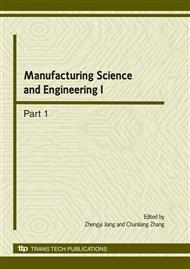p.1445
p.1450
p.1454
p.1459
p.1463
p.1467
p.1471
p.1475
p.1479
Fabrication of n-SiO2 Reinforced Al2O3 Composite Coatings on 7A52 Aluminium Alloy by Micro-Arc Oxidation
Abstract:
Micro-arc oxidation (MAO) is an effective approach to improve the properties of aluminium and its alloys by forming ceramic coatings on the surface. However, the oxide layers often have a porous surface structure, which limits their mechanical properties. In order to enhance the properties of the layers produced by micro-arc oxidation, SiO2 nanoparticles reinforced Al2O3 composite coatings were produced on 7A52 aluminium alloy by adding SiO2 nanoparticles into the electrolyte. With the addition of SiO2 nanoparticles in the electrolyte, the formation rate of Al2O3 coating enhanced considerably and the current density through the sample surface became much higher than that without SiO2 at the same voltage. The coatings were investigated with X-ray fluorescence spectrometry (XRF), Scanning electron microscopy (SEM), Vickers hardness test, and reciprocating friction and wear test. Compared with the Al2O3 coatings without SiO2 nanoparticles, the n-SiO2 reinforced Al2O3 composite coatings are much denser and harder, and the wear resistance is also improved significantly. The improvement can be attributed to the enhancement of the surface structure and morphology of the n- SiO2 reinforced Al2O3 composite coatings.
Info:
Periodical:
Pages:
1463-1466
Citation:
Online since:
March 2010
Authors:
Price:
Сopyright:
© 2010 Trans Tech Publications Ltd. All Rights Reserved
Share:
Citation:


